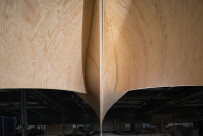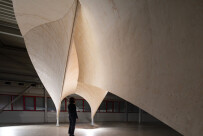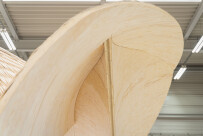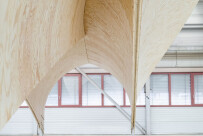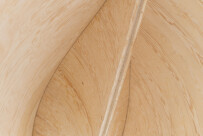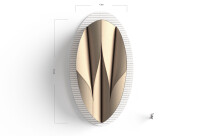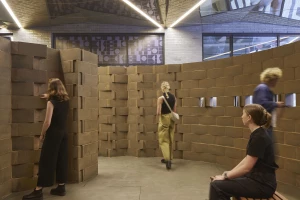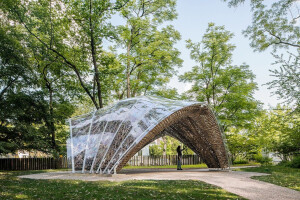HygroShell harnesses the hygroscopic properties of wood to achieve form and structure. (A hygroscopic material is one that can absorb and release moisture from the environment.) Described as a “self-constructing timber building system,” HygroShell makes use of advanced computational methods to access the inherent shape-changing nature of timber. This self-shaping system is demonstrated via the design, construction, and production of a wide-span, lightweight shell made using individual curved wood components.
Recent years have seen a growing interest in using timber as a construction material, replacing ubiquitous high-carbon materials such as a concrete and steel. Timber is especially beneficial when it comes to storing carbon, doing so for a structure’s lifetime (which can amount to hundreds of years). HygroShell explores what is billed as “a new kind of bio-based and bio-inspired architecture.”
HygroShell was developed as a research pavilion by students and researchers from the interdisciplinary ITECH MSc Program and the Cluster of Excellence Integrative Computational Design and Construction for Architecture (IntCDC) at the University of Stuttgart. The pavilion made its debut at the Chicago Architecture Biennial (taking place from 1 November 2023 – 11 February 2024).
HygroShell inside the James R. Thompson Center in Chicago:
The self-shaping properties of HygroShell
When first harvested, wood contains a high moisture content and begins to shrink naturally as it dries. A hygromorphic material, wood responds to changes in environmental humidity. HygroShell utilizes the hygromorphic properties of wood by constructing bilayer, cross-ply laminates: a thicker “active” layer with a high moisture content and a thinner “restrictive” layer with a low moisture content. The bilayer sheets then curve as the wood in the active layer begins to dry and shrink.
The HygroShell project team employed analytically-derived mechanical models to direct the natural properties of wood in a targeted way, resulting in a low energy, passive method of generating curved geometries. For the team, the anisotropy, structural characteristics of wood (where it is stronger along the grain) and the material’s abundance mean it is perfect for introducing the concept of self-shaping in construction, both economically and at scale.
Material driven computational design
HygroShell uses data that represents the natural material variations found in wood to drive the form, structure, and manufacturing process. The project team developed a custom computational workflow to ensure the delivery of precise material information throughout the design and fabrication process. This approach considered a range of factors that impact the overall shaping process and final structure, including grain orientation and wood moisture content.
The fabrication process begins with sawing spruce logs and ensuring the moisture content is maintained at a high level. Information about every board is gathered, including moisture content and grain orientation. Details are added into a digital data model, providing insight into each board’s physical and mechanical properties. Boards are then assigned a “curvature potential” according to their moisture content.
Next generation prefabrication
HygroShell’s defining aspect is described as “the ability to embed physical shaping, structure, connection detailing, weatherproofing, and cladding into flat layer-based prefabrication.” Unlike traditional prefabrication methods, it is not limited to standardized panels.
A precis of HygroShell’s prefabrication process:
10 x 3 meter (approx. 33 x 10 feet) wood bilayer layups are designed to be prefabricated lying flat on a table.
Curvature is programmed using the custom computational workflow. Twenty-millimeter-thick spruce wood boards with a high moisture content are placed within the active layer — they are glued to thin, four-millimeter pine plywood layers using a polyurethane adhesive and a combination of French cleat pressing and vacuum lamination.
A waterproof layer and diamond-shaped wood shingles (traditional in Southern Germany) are added in the controlled workshop environment. Acting like scales, they adjust to the surface curvature while maintaining weather protection.
The use of flat fabrication and assembly eases the manufacturing process without limiting the later geometric performance. The compact configuration of packages also minimizes transport volumes.
Self-shaping and sustainable
Once on-site, packages are set in a vertical position. Air-drying in an unconditioned environment, they change shape from flat to curved. To address the impact of natural humidity and seasonal changes, the project team developed a cyber-physical approach of monitoring curvature and moisture content, using a combination of iterative laser scanning and embedded IMU sensors. As each component reaches its final target shape, it is fixed with screws and a four-millimeter plywood layer is laminated to the inside of the curved bilayers — this locks the shape in place and increases form stability.
HygroShell was designed and engineered as a long-spanning roof structure. It comprises a span of 9.5 meters with intersecting arch-like vaults that rest on three articulated supports. The structural depth is a thin 28 millimeters. The project team explains that instead of using mass as reinforcement, HygroShell’s “lightweight system generates its stiffness through surface curvature and curved intersections.”
With its ability to bypass conventional wood drying techniques, HygroShell is an example of low-impact and sustainable construction. Moreover, the project team points to the fact that self-shaping eliminates the need for formwork and can ease the use of complex industrial machinery on construction sites.
Serving as a proof of concept, HygroShell demonstrates the possibilities of a self-shaping, lightweight timber building system that simplifies the construction of long-spanning curved surface structures.
This article is based on a detailed HygroShell report by the University of Stuttgart.
























